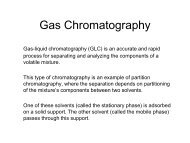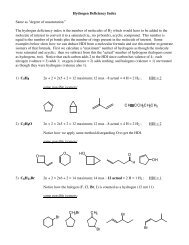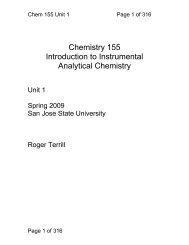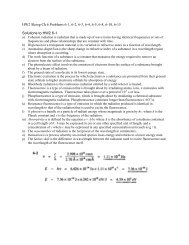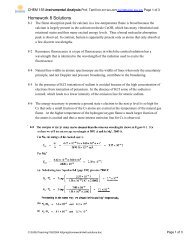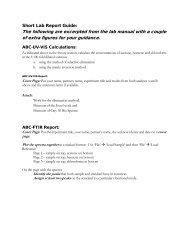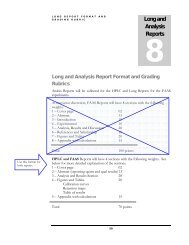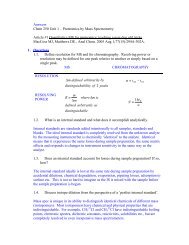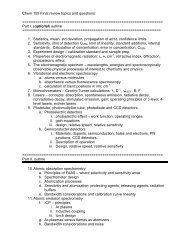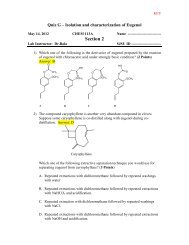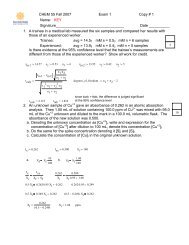Chem 155 Quiz 3 Review Topics
Chem 155 Quiz 3 Review Topics
Chem 155 Quiz 3 Review Topics
Create successful ePaper yourself
Turn your PDF publications into a flip-book with our unique Google optimized e-Paper software.
<strong>Chem</strong> <strong>155</strong> <strong>Quiz</strong> 3 <strong>Review</strong> <strong>Topics</strong>:<strong>Quiz</strong> 3 outline1. Atomic absorption spectrometrya. Principles of FAAS – where selectivity and sensitivity ariseb. Spectrometer designc. Atomization processesd. Sensitvitiy and atomization: protecting agents, releasing agents, radiationbufferse. Bandwidth considerations and calibration curve linearity2. Atomic emission spectrometrya. ICP – principlesi. Ar plasmaii. Inductive couplingiii. torch designb. Ar-plasmas versus flames as atomizersc. Bandwidth considerations and noised. Stability considerations, matrix effects and internal standardse. Monochromators, simultaneous multielement detection, Echelle designsand CCD array detection3. UV-Vis absorbance spectrometrya. Beer’s lawb. Molecular cross sectionsc. Non-Beer’s law behavior4. UV-Vis spectroscopy of Moleculesa. Pi, sigma, pistar and sigmastar molecular orbitalsb. Broad classificationsa. *b. n *c. n *, *c. Solvatochromisma. Increase in solvent polarity blue shift implies n * characterb. Increase in solvent polarity blue shift implies * characterc. Conjugation usually:i. Increases extinction of andii. red-shifts n *, * type transitionsd. Aromatic substitution with (-) charge density (e.g. –O - ) candestabilize pi system and red shift *e. Aromatic substitution with (+) charge density (e.g. -NH 3 + ) canstabilize pi system and blue shift *d. Aqueous transiton metal ionsa. Vis transitions are d-d based and weakb. Ligands like SCN- and o-phenanthroline can make charge transfercomplexes with large and therefore low DL (C MIN ).e. Photometric titrationa. uses C T and V T to determine concentration at inflection of A vs V Tb. does not use A, therefore does noti. require strict Beer’s law behaviorii. is insensitive to matrix effects that could change .
Path of analyte through plasma or flame <strong>Chem</strong> <strong>155</strong> <strong>Quiz</strong> 3 <strong>Review</strong> <strong>Topics</strong>:1. Fill in the empty boxes consistent with the diagram. SEE NOTESIn boxes 1 to 6 inddicate in what form theanalyte is likely to exist:65EmissionIn boxes 7 and 8 below put theequation that relates concentrationand light power corresponding toemission (7) and absorption (8):7HCLh4Absorption8321NebulizeLiqudsSolidsGases
<strong>Chem</strong> <strong>155</strong> <strong>Quiz</strong> 3 <strong>Review</strong> <strong>Topics</strong>:2. Compare Ar-plasma and air-C 2 H 2 flames in the following categories:Qualitycircle correctElectron Ar-plasma has higher lower equal air-C 2 H 2 flame.densitye - density thanTemperature Ar-plasma is higher lower equal air-C 2 H 2 flame.temperature than<strong>Chem</strong>ical Ar-plasma has higher lower equal air-C 2 H 2 flame.reactivityreactivity thanFormation of Ar-plasma is higher lower equal air-C 2 H 2 flame.oxideslikelihood thanAtomizationefficiencyAr-plasma is superior inferiorequal toair-C 2 H 2 flame.3. Compare inductively coupled plasma atomic emission spectrometry (ICP-AES)to flame atomic absorption spectroscopy (FAAS) in the following categories:Qualitycircle correctchoiceCost to buy / ICP-AES is higher, lower, FAASoperateequal cost thanSimultaneous ICP-AES is more, less, FAASMultielementdetectionequallycompetent thanDynamic Range ICP-AES has larger, smaller, FAASequal dynamicrange thanDetection Limit ICP-AES has higher, lower,equal detectionlimits thanFAAS4. Because of the mulit-element capability and atomization / temperature sensitivityof emission intensity, the following analytical method has proved highlysuccessful in ICP-AES:a. Standard addidions c. D2 background correctionb. Internal standards d. nonlinear calibration analysis5. Formation of oxides or molecular species in flame/plasma can be suppressedby:a. EDTA or other complexing agentsb. Addition of KCl to the matrixc. Addition of oxyanions such as sulfate or phosphate.d. Standard additions methods.6. Ionization of analyte atoms in flame/plasma can be suppressed by:a. EDTA or other complexing agentsb. Addition of KCl to the matrixc. Addition of oxyanions such as sulfate or phosphate.d. Internal standards methods.
<strong>Chem</strong> <strong>155</strong> <strong>Quiz</strong> 3 <strong>Review</strong> <strong>Topics</strong>:7. Fill in the following table assuming Beer’s law is obeyed:Absorbance P Po %T C / M0.00 1.000.30 1.001.00 1.00 0.0012.00 1.003.00 1.00A log %T10010 A %T100%T 10010 A100 10 0.3 50 100 10 1 10 100 10 2 1 100 10 3 0.1%T 100P P0P%T100 P08. Based on this, comment on the relative reliability (i.e. accuracy or precision) ofabsorbance measurements at A=1 and A=3.9. Associate each of thefollowing spectra withthe following solvent:a. Gas phaseb. Waterc. Cyclohexaned. Perfluorooctanee. Dioxane
<strong>Chem</strong> <strong>155</strong> <strong>Quiz</strong> 3 <strong>Review</strong> <strong>Topics</strong>:10. What is the function of the reagent blank in the metals experiment?To evaluate analyte levels in the Blank.11. What is the function of the spike recovery analysis in the metals experiment?To validate the sample preparation step.12. Circle the correct answer. In comparison to double-beam scanningspectrophotometers, diode array spectrophotometers are:QualitySpectrometer TypeDiode Array Double Beammore accurate absorbancemore accurate wavelengthmuch fastermore complexmore expensive13. Solvatochromism: correlate the following:Spectral Shift on transfer from hexane to alcoholTransitiontypePredominant effect seen in spectrum is:Shiftnonbonding (n) * orbitaldirection orbitalred blue stabilize destabilize stabilize destabilizen**14. Aromatic substitution:Spectral Shift on 254 nm * transition of benzene upon substitution with:Substituent ShiftdirectionEffect on orbital Effect on * orbitalOHO -NH 2NH 3+red blue stabilize destabilize stabilize destabilize
<strong>Chem</strong> <strong>155</strong> <strong>Quiz</strong> 3 <strong>Review</strong> <strong>Topics</strong>:15. Assuming that the absorption noise in your spectrometer, σ A = 0.001, what isyour detection limit for Fe +2 aquo ( MAX =1.0 M -1 cm -1 ) and FeSCN +2( MAX =5000 M -1 cm -1 ) in the 300-800 nm range?a. C MIN =3s b /mb. s b = Ac. m = slope of calibration curved. slope of calibration curve is (M -1 cm -1 )C M3s bm30.0011M 1 cm 1 3 10 3 cmM30.0015000M 1 cm 1 6 10 7 cmM16. Photometric titration of Fe+3 with SCN- solution to make FeSCN would givewhat titration curve?17. Why such a photometric titration be more accurate than relying on Beer’s law tomake the concentration estimate? Select all that apply:a. Matrix effects are unimportant in photometric titration.b. Photometric titration uses an internal standard.c. Beer’s law is always obeyed in photometric titrations.d. Beer’s law need not be obeyed in photometric titrations.e. Photometric titration relies on titrant volume and titrant concentrationwhich can be measured accurately.f. Photometric titration relies on absolute absorbance which can bemeasured exactly.g. Photometric titration does not require sample preparation.



